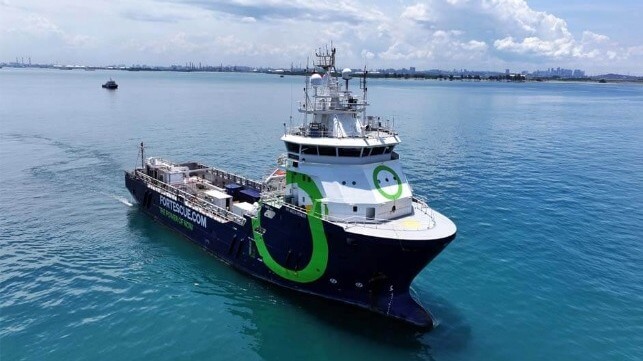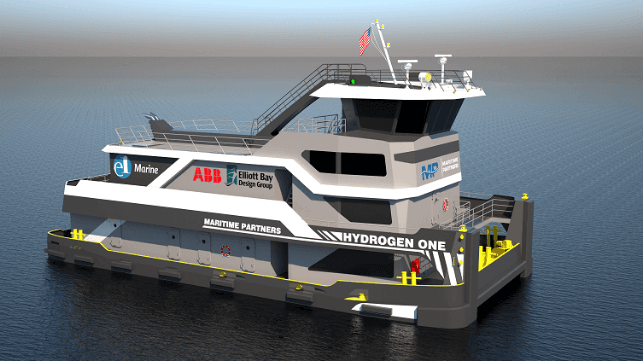ALT FUELS
Fortescue’s Ammonia-Fueled Ship Runs Propulsion and Maneuverability Tests

Sea trials continue for the first vessel operating on ammonia, an offshore supply vessel converted by Australia’s Fortescue. Earlier this year, the vessel completed the first marine bunkering of ammonia, and now after a second bunkering undertook the next phase of its ongoing sea trials.
The testing and trials are being conducted with the cooperation and close supervision of the Maritime and Port Authority of Singapore, where the vessel is registered. The MPA developed stringent safety protocols and reports it conducted Ammonia plume modeling and drone surveillance to support safety and incident planning and response. With a lack of maritime regulations in place for ammonia as a fuel. the MPA is using these first trials to develop the model for safe handling and operation of ammonia-fueled vessels.
Fortescue completed the conversion of the 2010-built MMA Leveque (3,100 dwt) in 2023 into the world’s first operational ammonia-fueled vessel. One of the four Cummins engines was converted for ammonia. The 246-foot PSV made her debut as the Fortescue Green Pioneer in late in 2023 and received the first notations from DNV and Singapore for ammonia operations after loading three tonnes of liquid ammonia and conducting seven weeks of tests in February and March 2024.
The next round began by loading a further four tonnes of liquid ammonia, along with diesel and Hydrogenated Vegetable Oil, a second-generation biofuel. Between April 23 and May 2, they conducted trials involving propulsion and maneuverability. The trials also included tests to validate the management of nitrogen-based emissions. They also assessed the vessel’s engine capability to operate on varying amounts of biofuel in combination with ammonia.
The trials took place in the Raffles Reserved Anchorage off Singapore. They are looking to complete the certification of the vessel and demonstrate the ammonia-fueled operations for the future of the maritime industry.
During February and March, the vessel completed a series of fuel trials. During those tests, the vessel was at anchor demonstrating the ammonia storage system, associated piping, gas fuel delivery system, retrofitted engines, and seaworthiness.
Fortescue is working with research institutes, industry partners, and government agencies including the MPA and DNV. The company plans to use the PSV to drive awareness of ammonia and demonstrate its operations for the marine sector.
Several other pioneering projects are also expected to proceed, including NYK is leading an effort in Japan to convert its LNG-fueled tug to begin operations later this year fueled by ammonia. So far, only a handful of ship owners have ordered ammonia-fueled vessels as they wait for these demonstrations and the commercial introduction of the engines and fuel systems required to adopt ammonia as a marine fuel.
USCG Agreement Sets Development Pathway for First Hydrogen-Power US Towboat

The project that has been underway for the past several years to develop the U.S.’s first hydrogen-power towboat reached a critical agreement with the U.S. Coast Guard that provides a pathway forward. Maritime Partners, which is leading the project, signed a Design Basis Agreement with the USCG for the Hydrogen One towboat that will use a novel technology that produces hydrogen aboard the ship eliminating the challenges of bunkering and storing hydrogen.
“The signing of this agreement opens the pathway for us to deploy our technological capabilities,” said Bick Brooks, co-founder and CEO of Maritime Partners. “With this, Hydrogen One is one step closer to becoming the world’s first vessel to utilize hydrogen generator technology greatly reducing emissions, increasing efficiency, and providing a model for cleaner energy use as the industry continues to seek ways to decarbonize.”
The DBA process was established by the U.S. Coast Guard to set the rules for new and novel technology proposed for installation on marine vessels. By reaching the agreement, they explained that the project would be working towards an agreed-upon framework with the U.S. Coast Guard for the design, arrangement, and engineering aspects of the power system and associated safety systems. It established a plan for the review, inspection, and eventual certification of the Hydrogen One.
The towboat is being designed as a first-of-its-kind vessel using new, cleaner, fuel cell technology that works by converting stored methanol to hydrogen. The produced hydrogen is output, on-demand, to the fuel cell to generate power for the vessel.
When the project was revealed in 2021, they said the towboat would be nearly 89 feet (27 meters) and designed to push barges from the Port of New Orleans along the Mississippi River and its tributaries. They projected the vessel will be able to travel for up to about four days at a speed of 6 knots, or cover a total of 550 miles, with a load between fueling. The concept called for a propulsion system capable of generating up to 2,700 HP propulsion power, with 1,700 HP generated by the fuel cell and the remainder from batteries.
The partners report that a string of successful tests of the technology were completed in Sweden in 2023. They said it demonstrated the viability of the technology as the sole power generation source for the vessel’s propulsion.
Maritime Partners worked with several industry leaders on the Hydrogen One project, including Seattle-based Elliott Bay Design Group, which is designing the towboat, and Intracoastal Iron Works which was selected as the shipyard to build the vessel. e1 Marine, which holds the license for the technology also worked with RIX Industries, Power Cell Group, among others, to work through the U.S. Coast Guard requirements. ABB Marine & Ports reported in 2021 that it would also participate in the project providing the electrical propulsion plant, including motors, transformers, and the integration of the fuel cell system.
Only a handful of hydrogen-powered vessels have entered service, mostly in Europe. In the U.S. the Sea Change ferry went through a long development process which experienced delays after the hull was launched in 2021 before it finally arrived in San Francisco in 2023. By entering the DBA process, the goal is to ensure a smooth process to move the Hydrogen One through design and into operation.
No comments:
Post a Comment